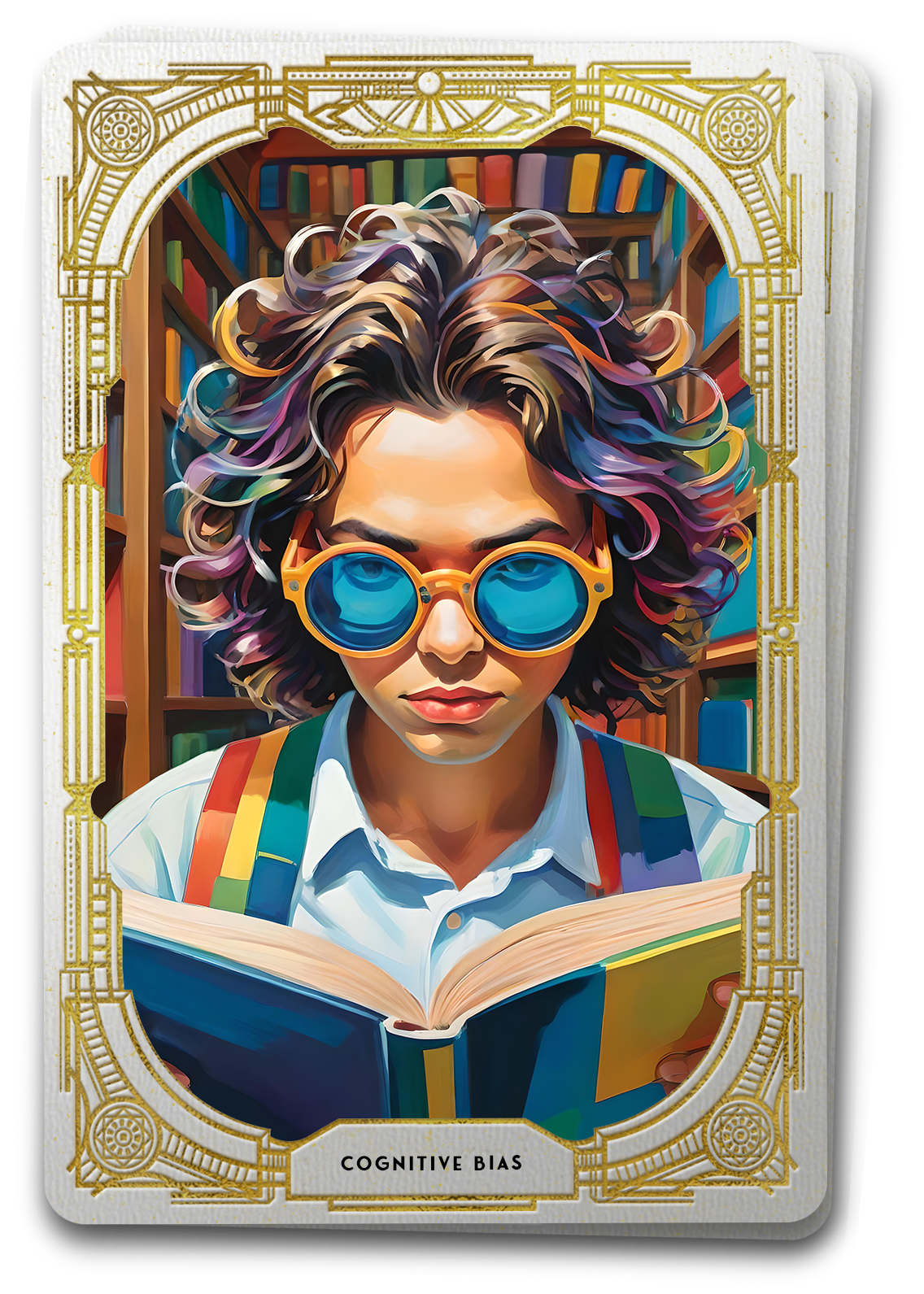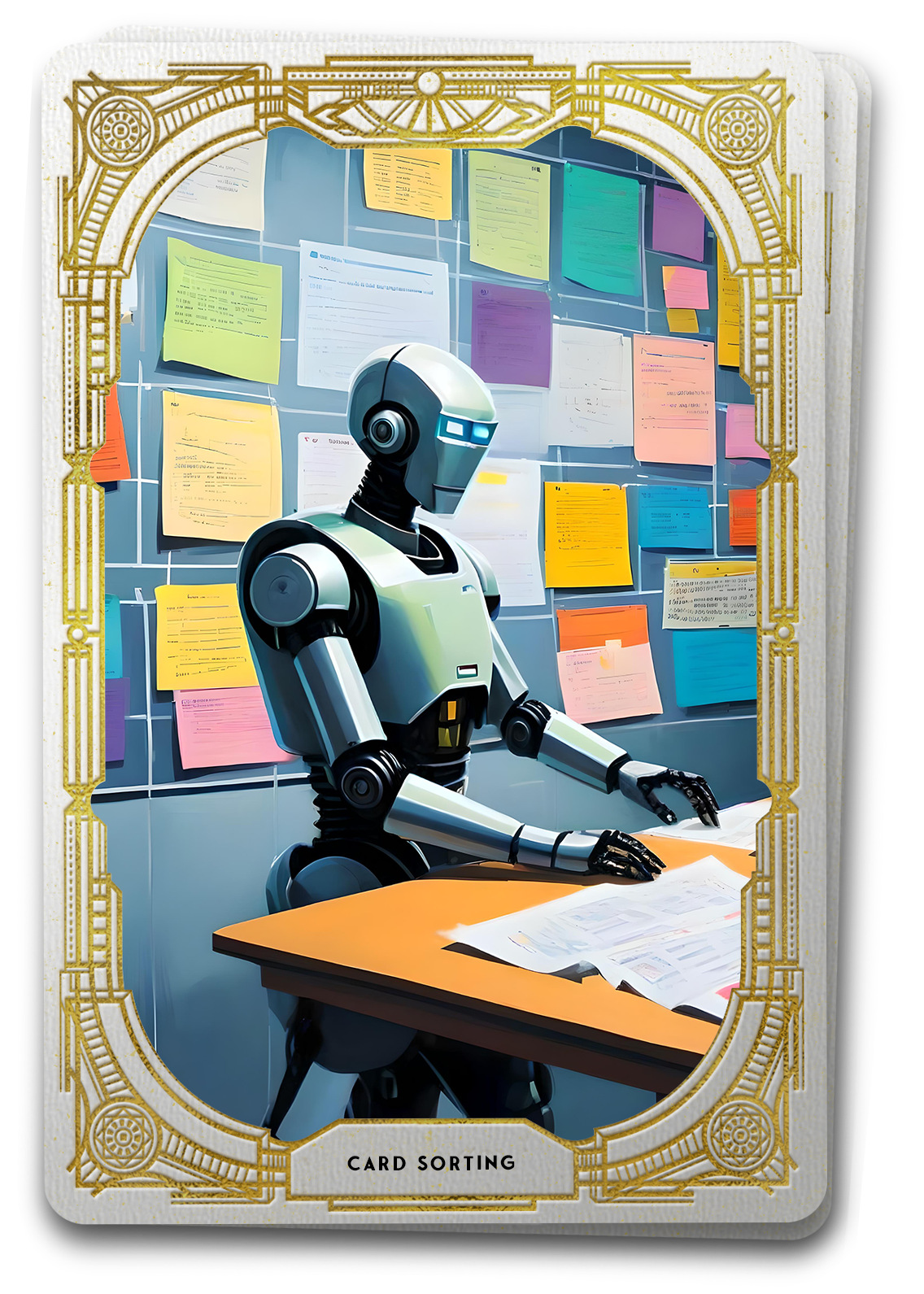
The Tarot Reveals Cognitive Bias:
Errors in our thinking impact how we view the world, make decisions, and interact with technology.
Imagine standing in a grand library, each book in the vast collection presenting a unique perspective on the world. However, there’s a twist – these books come with different filters, subtly altering the words on the pages. This distortion mirrors cognitive biases in the realm of user experience (UX) design. Similar to how these filters affect your understanding of the written word, cognitive biases shape how users perceive and engage with digital interfaces.
Unveiling Cognitive Biases in Design
In the intricate tapestry of user experience design, cognitive biases act as subtle yet powerful filters, shaping how individuals interpret and interact with digital platforms. These biases, characterized by systematic errors in thinking, play a pivotal role in influencing user decisions and experiences, often leading to unintended outcomes in the user journey.
Consider the “Confirmation Bias” as one of the prominent shades in our metaphorical library. Picture a reader selectively choosing books that confirm their existing beliefs, creating a skewed understanding of the broader literary landscape. Similarly, in UX design, users might gravitate towards information that aligns with their preconceptions, potentially missing out on crucial aspects of a product or service. Recognizing and mitigating this bias is akin to adjusting the tint on those glasses, aiming for a clearer, unbiased perception.
To achieve this, UX designers employ various strategies, with user testing playing a central role. By observing how users interact with a design, designers can identify instances where biases influence interpretation. For instance, a user testing scenario might reveal that the confirmation bias leads users to focus excessively on features that align with their expectations, prompting designers to rethink the presentation of information for a more balanced user experience.
A closely related concept is the “Bandwagon Effect,” reminiscent of our library visitors only noticing popular book choices. In UX, this bias manifests as users being influenced by the actions or preferences of others in a digital space. Designers can leverage this by strategically incorporating elements of social proof – reviews, testimonials, or user counts – subtly guiding users through decision-making processes.
Cognitive biases are not solitary phenomena; they often intersect and amplify each other. Picture the “Anchoring Bias” as the central column in our library, influencing the perception of all books around it. In UX design, this bias involves users heavily relying on the first piece of information encountered. Designers can strategically place vital information or calls-to-action at the beginning of user journeys, creating positive anchor points that shape subsequent interactions.
Historically, cognitive biases have been ingrained in human cognition for centuries, shaping decisions and perspectives. However, the digital age introduces new challenges. As we navigate the evolving landscape of user experience, understanding and mitigating these biases become paramount for designers striving to create interfaces that resonate with diverse user perspectives.
Practical Tactics for Mitigating Cognitive Biases in UX
Identify
Conduct User Research:
- Engage in comprehensive user research to understand the target audience’s demographics, behaviors, and preferences.
- Use surveys, interviews, and usability testing to uncover potential biases influencing user decision-making.
Analyze User Behavior:
- Scrutinize user interactions with your digital interfaces, paying attention to patterns that might indicate confirmation biases, anchoring effects, or other cognitive influences.
- Monitor analytics to identify recurring user pathways, preferences, and decision points.
Feedback Mechanisms:
- Implement feedback mechanisms, such as user surveys or feedback forms, to directly inquire about user perceptions and potential biases.
- Encourage users to share their experiences and thought processes during usability testing sessions.
Plan
Create User Personas:
- Develop detailed user personas based on research findings, incorporating factors like demographics, psychographics, and potential cognitive biases.
- Use these personas as a reference throughout the design process to empathize with and understand user perspectives.
Consider Cultural Context:
- Recognize that cognitive biases can vary across cultures. Conduct research specific to the target audience’s cultural background to identify and address culture-specific biases.
Diversify Design Teams:
- Build diverse design teams that bring a range of perspectives to the table, reducing the risk of team-wide cognitive biases.
- Encourage open discussions about potential biases during the design process
Mitigate
Information Hierarchy:
- Design interfaces with a clear information hierarchy, placing crucial information at the forefront to combat anchoring biases.
- Use visual cues such as color, size, and positioning to guide users towards essential elements.
Counter Confirmation Bias:
- Present diverse information to users, challenging preconceived notions and offering a more comprehensive view.
- Use neutral and inclusive language to minimize the impact of confirmation bias during information consumption.
Leverage Social Proof:
- Integrate social proof elements strategically, showcasing positive user experiences, reviews, and testimonials to counteract potential bandwagon effects.
- Implement user counts or activity indicators to subtly influence user behavior.
Iterative Prototyping:
- Employ an iterative prototyping approach, continually testing and refining design elements based on user feedback.
- Regularly reassess the design to ensure it aligns with evolving user expectations and doesn’t inadvertently introduce new biases.
Educate Users:
- Implement onboarding processes that educate users about potential biases and guide them towards making informed decisions.
- Use tooltips or interactive elements to provide explanations for complex or critical information.
Accessibility Considerations:
- Ensure that interfaces are accessible to users with varying cognitive abilities, reducing the risk of biases affecting individuals with specific needs.
- Prioritize simplicity and clarity in design to accommodate diverse user backgrounds.





